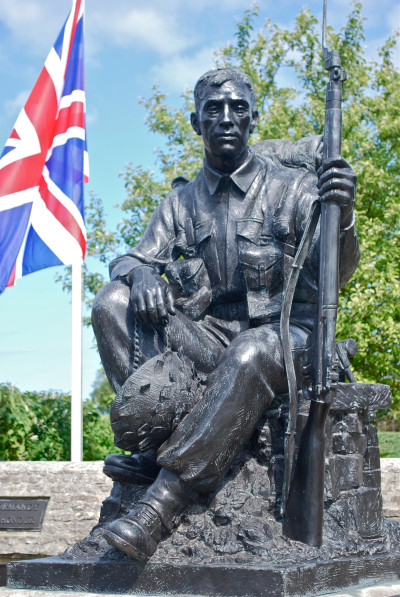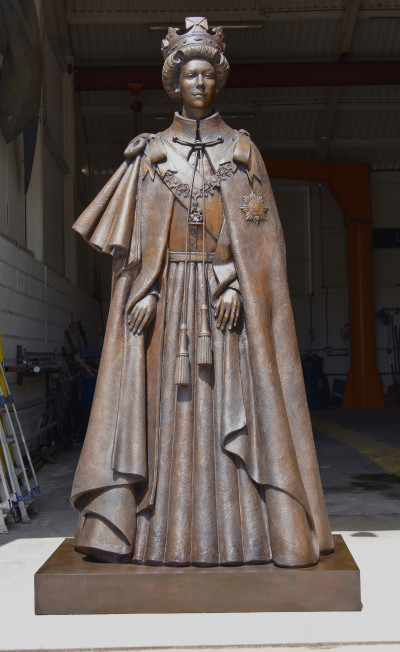In memoriam: James Butler RA
In memoriam: James Butler RA
By John Maine RA
Published 28 June 2022
John Maine RA pays tribute to a fellow sculptor, whose fidelity to figuration bore fruit in military monuments and major commissions.
-
-
James Butler (1931–2022), or Jim as I knew him, saw himself as a practical working sculptor in a figurative tradition. He observed the detailed appearance of his subject and interpreted it in three-dimensional form. Whereas some sculptors create a pure calm space to develop their ideas in isolation, Jim was stimulated by a bustling workshop atmosphere – his studio was busy with an array of tools and materials alongside works in progress. He loved process, and relished the transformation of clay or bronze into new life through gouging, shaping, pressing and cutting, until it became a portrait or figure in action.
His sense of art history was founded on the technical side of sculpture, having worked with Italian craftsmen and learned their traditional methods. He became highly skilled in reproducing the appearance and detail of the human form, paying great attention to the fabric of clothing and props.
Jim was elected to the Academy as an Associate in 1964 before becoming a Member in 1972, and while traditions were changing at the RA and elsewhere in very different ways to his sculpture, Jim kept going with faith in his own approach. When he was starting out, he adopted a ‘never say no’ attitude, which led to a very broad range of projects; then as he began to secure larger commissions, he concentrated on major public pieces and smaller personal works.
Jim had a natural rapport with many of the subjects of his military portraits. His deep respect for these heroic characters gave a real conviction to their portrayal. His First World War memorial in France, which honoured the Rainbow Division, was much more than just a job of work. Before its installation in 2011 at Croix Rouge Farm, in Fère-en-Tardenois, the sculpture was exhibited in the Annenberg Courtyard at the Academy near the memorial tablet to the Artist Rifles regiment. Inspired by Charles Sargeant Jagger, it portrayed an American soldier carrying a fallen comrade, like a Pieta.

-
-
He loved process, and relished the transformation of clay or bronze into new life through gouging, shaping, pressing and cutting
John Maine RA on James Butler RA
-
Not all of his monuments are solemn, however, as there are animated and playful works, and historical characters of all kinds. Jim also took on important projects for the Royal Mint, such as the Great Seal of the Realm for Her Majesty the Queen.
I remember hanging a room in the Summer Exhibition for the first time, and being so impressed that Jim’s small bronze figures could animate the gallery in an unexpected way, alongside the larger abstract work of sculptors such as Phillip King RA and Bryan Kneale RA. Their works were completely different in terms of intention and execution, but the Academy can sometimes bring together pieces across generations and attitudes, and surprise us. It can be a gathering of disparate minds rather than a consensus of any style or approach. For many, Jim was a significant link to traditions of portraiture in sculpture.
-

James Butler RA, D Day Memorial to the Green Howards.

James Butler RA, The Young Queen.

James Butler RA, Head of a Woman, 1962.

James Butler RA, Model Waiting.
-
There is also a social aspect to the Academy, and I know that Jim enjoyed the RA Dining Club that was organised by the Members, often attending with Angie, his wife. It must be said that he regretted our occasional lapses, such as the time when there was no mustard with the beef, but he was too much of a gentleman to hold it against us for long.
Even though he made many public works, Jim was essentially a reserved and private person. He had a steady work schedule, and lived quietly with his family and his dogs. At the Academy we always found him courteous, and he carried himself modestly; never self-promoting, although he had so very much to offer. His sculpture speaks for him.
John Maine RA is a sculptor.




